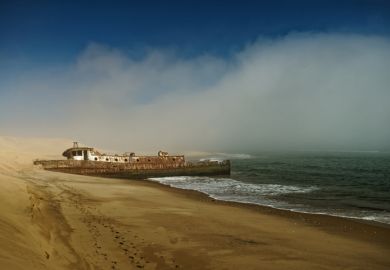World history has recently taken a surprising turn. It has lost its western clothing, although its new appearance has a long way to go before it gets general acceptance in the scholarly marketplace. Major social thinkers in the 19th century - Marx and Weber in sociology, Smith and Malthus in economics - saw that they had a role to explain the rise of capitalism, modernisation, industrialisation in the West and "the fall of Asia" (and the failure of the East to participate).
What advantages did Europe possess, what blockages existed in Asia? In the 20th century the inquiry has continued in the hands of Fernand Braudel, Immanuel Wallerstein, K. N. Chaudhury and David Landes, and in a less comparative way by scholars like E. T. Jones, Lawrence Stone, Norbert Elias and many demographic historians who, implicitly, have looked at the East from the standpoint of western industrial "superiority". The sociologists and social historians among them have tended to look for deep-rooted, long-standing cultural differences, while economists and economic historians have been prepared to see more recent divergences of a technological kind - for there is no doubt that earlier, since the Bronze Age, Asia had taken the lead in the "civilising process". Both groups of European scholars have tended to find in the East the foil that their initial question anticipated.
Such a Euro-centred approach has been attacked in general terms by J. Blaut and in more specific ones by Andre Gunder Frank. Now Kenneth Pomeranz, an economic historian of China, proposes we should ask the question in another way. Why was it that developed areas like the Yangtze delta followed a different tack?
Although Pomeranz uses China and Europe in the title of this book, in fact he rejects these as units of comparison, arguing that we need to compare "core areas" throughout Eurasia that were similar in terms of population density, of commercialised agriculture, of relatively free markets, of security of property and extensive handicraft industries (proto-industrialisation). For we were living in a polycentric universe until 1800. As a result, he isolates several "core areas" in China, in Japan and in India, which he sees as having similar characteristics to Western Europe (specifically England and the Netherlands) in respect of the economy and of resource constraints occasioned by the levels of population and the demands on food, fuel, housing and handicrafts. These demands raise ecological problems and the great divergence was in the way that these were met.
Until that divergence, he argues, the economics of the core areas had been basically level-pegging. His arguments are based primarily on analysing economic data of a neo-classical, market-driven kind, though ecological considerations are central, even if political, ideological, religious and family ones are not.
His assessment of the similarities in core areas as late as 1800 is based not upon intuition or informed opinion but upon detailed measures, some of which he has constructed himself. This leads him to counter the widespread assumption that Europe, and in particular England, was more prepared than other core areas for the adoption of industrialising strategies, in terms of markets, capital availability or security of investment. While he acknowledges the existence of small differences (eg in interest rates), in his view these could not account for the radical nature of the "great transformation" that later took place. Indeed, in some ways Europe profited from the "advantages of backwardness", for example, in relation to land use that allowed for expansion. However, through measuring the consumption of sugar and other everyday "luxuries", such as tea and coffee, he tries to show the similar patterns that existed in these core areas. There were not only similarities in the use of luxuries such as works of art, to acquire and consolidate status in the more fluid hierarchies that evolved in densely inhabited areas; there was also a similar resentment by old elites of new ones, especially in their use of fashion and avoidance of sumptuary laws. Discourses such as "A Treatise on Superfluous Things" in China began to appear slightly earlier than their European equivalents.
Pomeranz suggests that all of these core areas had, in a sense, reached the limits of their potential growth at technical and organisational levels, and were facing similar constraints of an ecological kind on maintaining standards of living. These constraints could be temporarily removed by drawing in the economics of peripheral areas that supplied land-based products in return for the export of handicrafts and know-how, filling the shortfall in necessities of food, fuel, fibres and building materials. But eventually the periphery would catch up with the core. This is where the great divergence arose. These ecological constraints could be countered by pursuing either labour-intensive or capital-intensive strategies. The first led to the Chinese "cul-de-sac", the latter to western industrialisation. England was able to initiate the second course not primarily because of inherited entrepreneurial skills, nor because of superior levels of science and technology, nor even through religious ethics or cultural ideology, but partly because of geographical accident. This brought together deposits of coal and iron, which solved the energy crisis in a way that circumvented the ecological constraints (on the use of metals for example) imposed by the destruction of available forests. Most important was the "military fiscalism" that led to overseas wars and the establishment of colonies. Here again England was particularly fortunate in its expansion to America, where emptied lands and slave plantations could produce export crops of tobacco, sugar and especially cotton, products for which there was insufficient land in the core area. This Pomeranz sees as the foundation on which industrialisation was built, since the colonies not only supplied the raw products but also offered a market for handicrafts and manufactured goods.
The great strength of this notable book is the use of detailed economic data to refute prejudices based on later economic achievements of the West. That strength could also be a source of disagreement because of the neo-classical framework - extended to ecology - with its assumptions of "rational optimisation". Non-economic valuables, too, are effectively discounted, especially when one is dealing with Eurocentric writers who take a very different line on the question of long-term and short-term advantages. Very pragmatically, Pomeranz sees Britain as favoured in the transition to fossil fuels, escaping reliance on wood, and as having its industry supplied by fibres from America. Other supposed advantages in economic ethics or entrepreneurial skills are quietly circumvented. But, at one point, he does refer to the presence in Europe of printing in an alphabetic script and that did surely offer some advantage in the accumulation and circulation of knowledge about inventions or improvements in industry and agriculture, linked to the so-called scientific revolution. The technological concomitants of this revolution and their contribution to sustainable growth could perhaps have received more emphasis.
But this is a profoundly thought-provoking book which will change the terms of the debate about the origins of capitalism, the rise of the West and the fall of the East.
Jack Goody is a fellow, St John's College, Cambridge.
The Great Divergence: China, Europe and the Making of the Modern World Economy
Author - Kenneth Pomeranz
ISBN - 0 691 00543 5
Publisher - Princeton University Press
Price - £25.00
Pages - 382



